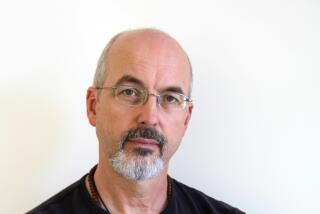Hot Young Artist’s Solo Exhibit Opens in La Jolla
LA JOLLA — Meyer Vaisman is hot. Just 28, this firecracker from Caracas, Venezuela, has already had 42 art exhibits in such widely separated cities as New York, Los Angeles, Copenhagen, Amsterdam and Naples. In the process he has challenged some traditional notions about art.
Now, with his first solo museum exhibition of seven new works through July 17 at the La Jolla Museum of Contemporary Art, Vaisman has officially earned Wunderkind status, if there were ever any doubts; museums do not give solo exhibits to just any 28-year-old.
Vaisman, along with his fellow young innovators in New York--Ashley Bickerton, Jeff Koons and Peter Halley--is at the center of the contemporary art world’s latest controversial movement that has been dubbed “Simulationism.”
Simulationists are accused of art heresy in blurring the line between art and consumer products by mimicking or simulating both. The Simulationist movement is based on the artists’ readings of French theorist Jean Baudrillard, who has noted the rise of image over reality in contemporary society, according to Eleanor Heartney in “ARTnews.”
By doing that, Heartney says, Vaisman and his contemporaries have also altered the perception of the artist’s role.
More Orthodox Role
Vaisman, however, sees himself in more orthodox terms.
“I think it is important for artists to represent the cultural moment they exist in,” he said in an interview at the La Jolla museum. “In the ‘70s, there wasn’t that much of an interest in art on the part of collectors because of recessions and inflations and that sort of thing. So what artists started doing was to make works of art that only existed as an installation or a work of art that only existed in the landscape like Robert Smithson did with his ‘Spiral Jetty.’
“But in the ‘80s there has been a great interest in money again. As artists, I think it’s our responsibility to touch on that as an aspect of the work.”
Vaisman stresses the idea that today image is paramount in our society. As an example, he noted the popularity of President Ronald Reagan.
“He is an actor and that’s why people like him,” Vaisman said. “It doesn’t matter if Reagan is a good President or a bad President. It just matters if he has that good TV personality.
“It’s interesting to me that elections are coming up and people are saying Bush is so boring and Dukakis is so boring. And they don’t think, well, they’re good or they’re interested in their programs. They just want to be entertained by the President.
“The image as a sign becomes detached from the actual activity. And it’s something that finally the Russians were able to understand. You have Gorbachev who is just as wonderful as Reagan on television. “I believe there are very strong changes in the culture. Without a manifesto being written or anything like that, it’s just in the air.”
Born in Caracas and educated at Parsons School of Design in New York, Vaisman opened an art gallery in New York with two fellow artists in 1984. The International With Monument Gallery featured the work of fellow Simulationists.
At first it attracted little attention. But within three months the gallery was under siege, giving Vaisman an appreciation for the work of art dealers.
“The gallery was flooded with calls,” Vaisman said. “It got to be too much like commercial galleries. I spent my time, you know, hearing people scream why they didn’t get this, why they didn’t get that, and I decided I had to quit. It just became maddening.”
The artists closed the gallery, and concentrated on making art.
Vaisman’s La Jolla exhibit is exemplary of his work with its use of silk-screened reproductions, often kitsch commercial images, mounted on large canvas backgrounds printed with photographic enlargements of a textile weave. The artworks, which look raw and rough compared with art produced before the 1950s, aren’t likely to win kudos for beauty.
But Vaisman isn’t so much concerned with beauty as he is with the image of art itself and the artist’s role in today’s burgeoning art market; unlike some artists, Vaisman sees art as a business.
“I think art is a commodity whether it sells or it doesn’t,” he said. “It’s still a commodity of sorts. The fact that it isn’t produced in large quantities doesn’t make it any less of a commodity.”
His use of commercial mechanical copying techniques in creating art, a la Andy Warhol, underscores his point about the artist’s role. Rather than draw his self portrait and a portrait of his girlfriend--a bow to an art tradition dating back centuries--Vaisman silk-screened caricatures of them drawn by a street artist.
Caricature is elemental in Vaisman’s work, not only in the subject matter but also as part of the process.
“Twentieth century art is all based on caricature, which is something that really isn’t talked about that often,” he said. “It’s something that interests me a lot. When you see Picasso, Matisse, Giacometti, all those were very much involved in caricature, and nobody talks about it.”
More to Read
The biggest entertainment stories
Get our big stories about Hollywood, film, television, music, arts, culture and more right in your inbox as soon as they publish.
You may occasionally receive promotional content from the Los Angeles Times.










